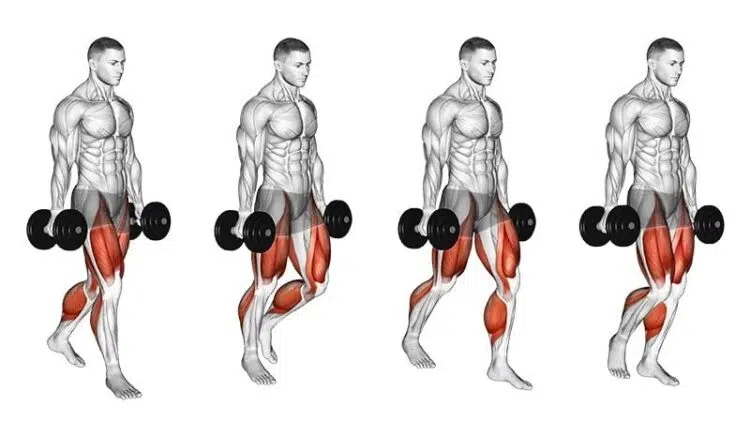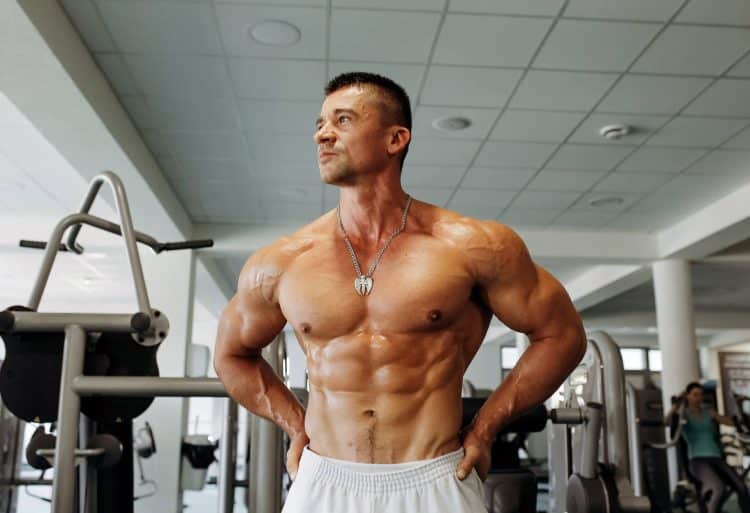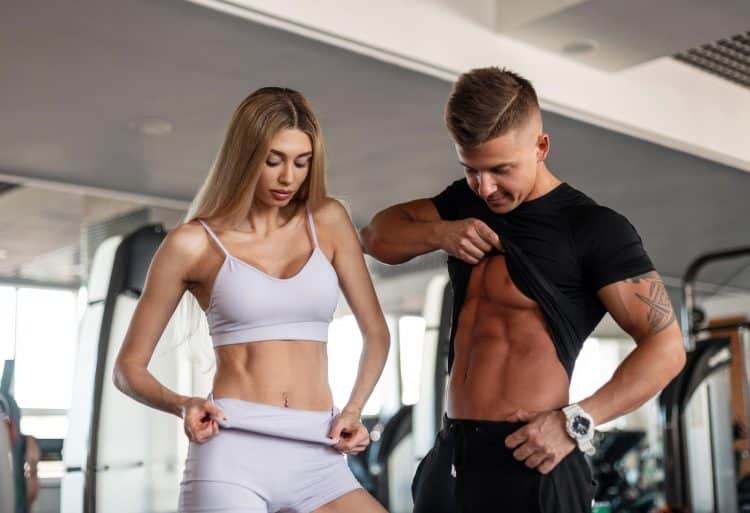Strength training exercises can be categorized in several ways. These classifications are meant to make choosing the right exercise for your goals easier. Common exercise categories include isolation, compound, open chain, closed chain, and functional.
As a veteran personal trainer, in my opinion, it’s this last label that’s the most misunderstood and misused.
As far as I’m concerned, a functional exercise should prepare your body for the demands of daily living or your chosen sport. In addition, it should reduce your risk of injury, further enhancing your functionality, hence the name. In fact, studies suggest that well-chosen functional exercises can enhance athletic performance and reduce the risk of injury (1).
However, according to many trainers, functional exercises are incredibly complicated or require a high level of balance and coordination. For example, doing squats while balancing on a stability ball.
Caption: This is NOT a good example of functional training!
While such exercises could be described as functional if you are an acrobat at the circus, for everyone else they’re a potentially dangerous waste of time!
Level Up Your Fitness: Join our 💪 strong community in Fitness Volt Newsletter. Get daily inspiration, expert-backed workouts, nutrition tips, the latest in strength sports, and the support you need to reach your goals. Subscribe for free!
My rule for functional exercises is that they must replicate a movement that you perform regularly. That’s why things like deadlifts, step-ups, overhead presses, and bent-over rows are at the top of my functional must-do exercise list.
In this article, I want to discuss the transformative power of another functional exercise – the farmer’s walk. After all, picking up and then carrying a heavy object is something that most people do regularly, or dread because it’s such hard work.
This simple yet challenging exercise builds real-world, full-body fitness and strength and is the epitome of functional training.
Farmer’s Walk Basics
The farmer’s walk, also known as the farmer’s carry, is a very straightforward exercise. This simplicity means that almost anyone can incorporate it into their workouts, even complete beginners.
You can learn all about how to do farmer’s walks in this detailed guide but, to save you from page-hopping, here’s a simple step-by-step guide to getting started with this awesome exercise.
- Place two dumbbells on the floor about shoulder-width apart, handles running parallel.
- Stand between the weights with your feet roughly shoulder-width apart.
- Squat down and grip the handles so your hands face inward – a neutral grip. Hold them tightly, wrapping your thumbs around your fingers if possible.
- Drop your hips, lift your chest, brace your core, and pull your shoulders down and back.
- Keeping your arms straight, drive your feet into the floor to stand up.
- With your arms long and your core tight, go for a walk around your training area.
- Continue for the prescribed distance, e.g., 20 yards, or time, e.g., 60 seconds. Alternatively, continue until your grip starts to fail.
- At the end of your set, bring your feet back in line, bend your legs, and squat down to lower the weights back to the floor. Take care not to round your lower back, as doing so could lead to injuries.
Pro Tips:
- Use gym chalk to stop your hands from slipping. Alternatively, dry your hands on a towel before each set.
- Keep your upper back engaged throughout – do not let your arms hang passively from your shoulders.
- Keep your head and chest up. Do not look down at your feet or slouch. Poor posture could lead to injuries.
- Avoid holding your breath as doing so can raise your blood pressure and could make you feel dizzy or faint (2).
- No space to do lengthy farmer’s walks? No problem – do dumbbell step-ups instead. They provide all the same benefits while being better for small training areas.
How Farmer’s Walks Transform Your Body
What are the benefits of doing regular farmer’s walks? I’m glad you asked! This is how farmer’s walks will transform your body.
Increased Grip Strength
Gripping dumbbells while you walk will challenge and strengthen your grip. A stronger grip makes many everyday activities easier, from opening jars to using a spanner or screwdriver to taking out the trash. Grip strength is also important in many sports, such as rock climbing, wrestling, weightlifting, armwrestling, and football.
However, all these benefits pale into insignificance when you consider the health benefits of having a stronger grip.
Research suggests that people with a strong grip live longer, better lives than their limper-wristed peers (3). All types of exercise are good for your health, but it appears that regular farmer’s walks could extend your lifespan.
Better Posture
Posture is best described as the alignment of joints, and it can be good or bad. Good posture “stacks” your bones so that your muscles don’t have to work so hard to support them. For example, sitting or standing upright.
In contrast, poor posture pulls your joints out of alignment, and you’ll have to work much harder to support those misaligned limbs and body parts. For example, hunching forward at your desk or thrusting your head toward a computer screen.
Related: Exercises to Fix Your Nerd Neck and Desk Slouch
While you can perform farmer’s walks with poor posture, doing so will make an already challenging exercise even harder. You’ll find it much more comfortable and efficient if you walk tall with your chest up and shoulders back.
Practicing good posture during farmer’s walks will undoubtedly make you more posturally aware in other parts of your life, teaching you to sit and stand more upright.
A Stronger, More Toned Core
Core is the collective term for the muscles that make up your midsection. These include:
- Rectus abdominis
- Obliques
- Transverse abdominis
- Erector spinae
- Pelvic floor
- Diaphragm
These muscles form a cylinder which, when it squeezes inward, creates intra-abdominal pressure to support your lumbar spine. As such, they work much like a corset or weightlifting belt. A strong core can help reduce your risk of back pain (4) and is also linked to better athletic and functional performance (5).
Level Up Your Fitness: Join our 💪 strong community in Fitness Volt Newsletter. Get daily inspiration, expert-backed workouts, nutrition tips, the latest in strength sports, and the support you need to reach your goals. Subscribe for free!
Farmer’s walks challenge your core without involving flexion, extension, lateral flexion, or rotation of your spine. Consequently, they provide an effective yet safe way to strengthen your midsection.
Will doing farmer’s walks give you a six-pack? Not directly. However, paired with a sensible, sustainable fat-loss diet, they will tone your core muscles and make them more defined.
Increased Muscularity
Heavy farmer’s walks can help develop many of your major muscles including:
- Forearms*
- Biceps*
- Triceps
- Deltoids*
- Trapezius*
- Core
- Quadriceps*
- Hamstrings*
- Hip abductors
- Hip adductors
- Gluteus maximus*
- Gastrocnemius*
- Soleus*
However, those muscles marked with an asterisk (*) receive the most stimulation and are the most likely to grow bigger.
Farmer’s walks are a classic strength and conditioning exercise, but bodybuilders don’t tend to use them very much. That’s a shame because walking with dumbbells is a great way to develop numerous muscles, especially the all-important forearms and upper traps.
Increased Bone Density
Farmer’s walks don’t just build stronger muscles, they strengthen your bones, too. Loading your bones stimulates cells called osteoblasts to lay down new bone tissue. The result is a measurable increase in bone strength and density (6).
Done density tends to decrease with age, especially in women. This can lead to osteopenia and osteoporosis, which are conditions characterized by weak, porous bones that are prone to fracture. Bone breaks in older people are often serious, sometimes resulting in long-term disability.
Farmer’s walks are a low-impact yet high-effect exercise for increasing bone mass. As such, they are an excellent choice for any exerciser who wants to preserve or increase bone density.
Fat Burning
A tough set of farmer’s walks will elevate your heart and breathing rate despite the fact this isn’t a traditional cardiovascular exercise. This effect can help contribute to fat burning and weight loss, especially if you do farmer’s walks regularly and with sufficient intensity and duration.
How is this possible?
Simply put, doing several sets of farmer’s walks is a form of high-intensity interval training or HIIT for short.
HIIT is renowned for burning lots of calories during your workout and elevating your post-exercise metabolic rate, further increasing your energy expenditure (7). Combined with a sensible diet, farmer’s walks could help you reach and maintain your ideal weight and body composition.
Improved Functional Strength
Have you ever struggled to lift and carry a child, pet, suitcase, garbage can, or grocery sack? Many people are unable to perform or avoid these types of activities because they find them so challenging.
However, you’ll struggle no more if you make farmer’s walks part of your exercise routine. This movement trains you to lift and carry heavy objects, making it a bonafide functional exercise.
With farmer’s walks in your training schedule, you’ll no longer dread picking up your kids or carrying your groceries to your car. Instead, you’ll be able to celebrate your ability to do something that many other people are just too weak to do, and that feels really good!
Farmer’s Walks: How Often, How Heavy, How Far
There is no one-size-fits-all prescription for farmer’s walks, and what’s right for one person could be too little or too much for another.
With that said, as a personal trainer, I usually encourage my clients to do this exercise 3-4 times per week, use 25-50% of their body weight per hand, walk 20-40 yards, and do 3-5 sets per workout.
Needless to say, most exercisers will need to work up to these standards, and rushing to meet them could cause injury.
So, start as light as you need to, and adjust the distance and number of sets based on your fitness and experience. Gradually add weight, yards, and volume as your body adapts to this powerful, life-changing exercise.
Closing Thoughts
Getting fitter, stronger, leaner, and healthier can often seem like a complex process that requires access to state-of-the-art equipment and marathon daily workouts.
But, as an experienced personal trainer and former British Royal Marine, I know that this isn’t necessarily the case. In fact, you can get in great shape without fancy facilities or spending hours in the gym.
The farmer’s walk is one of the most time-efficient exercises you can do; you just need to commit to doing it regularly. So, pick up your dumbbells and take them for a walk. While this might be an unconventional exercise, I guarantee it has the power to change your body for the better.
References:
- Wang X, Soh KG, Samsudin S, Deng N, Liu X, Zhao Y, Akbar S. Effects of high-intensity functional training on physical fitness and sport-specific performance among the athletes: A systematic review with meta-analysis. PLoS One. 2023 Dec 8;18(12):e0295531. doi: 10.1371/journal.pone.0295531. Erratum in: PLoS One. 2024 Feb 16;19(2):e0299281. doi: 10.1371/journal.pone.0299281. PMID: 38064433; PMCID: PMC10707569.
- Hackett DA, Chow CM. The Valsalva maneuver: its effect on intra-abdominal pressure and safety issues during resistance exercise. J Strength Cond Res. 2013 Aug;27(8):2338-45. doi: 10.1519/JSC.0b013e31827de07d. PMID: 23222073.
- Halaweh H. Correlation between Health-Related Quality of Life and Hand Grip Strength among Older Adults. Exp Aging Res. 2020 Mar-Apr;46(2):178-191. doi: 10.1080/0361073X.2020.1716157. Epub 2020 Jan 12. PMID: 31928183.
- Hlaing SS, Puntumetakul R, Khine EE, Boucaut R. Effects of core stabilization exercise and strengthening exercise on proprioception, balance, muscle thickness, and pain related outcomes in patients with subacute nonspecific low back pain: a randomized controlled trial. BMC Musculoskelet Disord. 2021 Nov 30;22(1):998. doi: 10.1186/s12891-021-04858-6. PMID: 34847915; PMCID: PMC8630919.
- Rodríguez-Perea Á, Reyes-Ferrada W, Jerez-Mayorga D, Chirosa Ríos L, Van den Tillar R, Chirosa Ríos I, Martínez-García D. Core training and performance: a systematic review with meta-analysis. Biol Sport. 2023 Oct;40(4):975-992. doi: 10.5114/biolsport.2023.123319. Epub 2023 Feb 3. PMID: 37867742; PMCID: PMC10588579.
- Kitsuda Y, Wada T, Noma H, Osaki M, Hagino H. Impact of high-load resistance training on bone mineral density in osteoporosis and osteopenia: a meta-analysis. J Bone Miner Metab. 2021 Sep;39(5):787-803. doi: 10.1007/s00774-021-01218-1. Epub 2021 Apr 13. PMID: 33851269.
- Khodadadi F, Bagheri R, Negaresh R, Moradi S, Nordvall M, Camera DM, Wong A, Suzuki K. The Effect of High-Intensity Interval Training Type on Body Fat Percentage, Fat and Fat-Free Mass: A Systematic Review and Meta-Analysis of Randomized Clinical Trials. J Clin Med. 2023 Mar 15;12(6):2291. doi: 10.3390/jcm12062291. PMID: 36983289; PMCID: PMC10054577.











